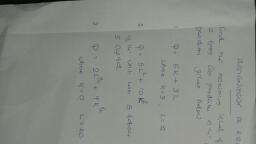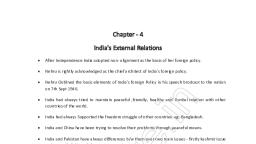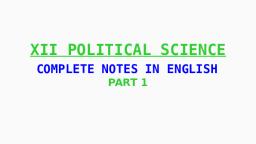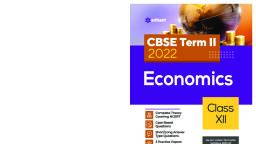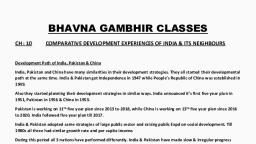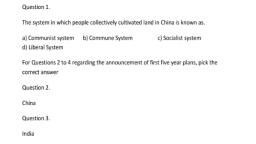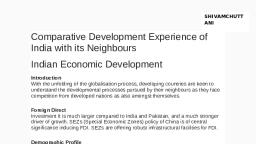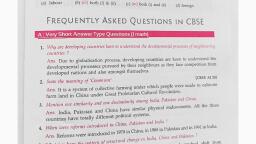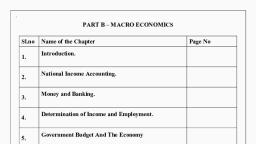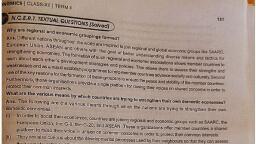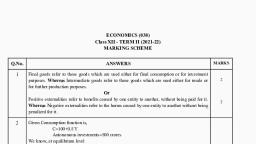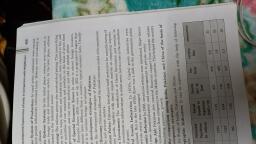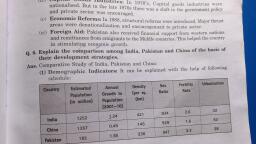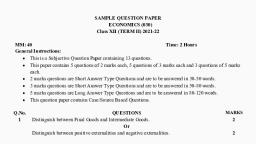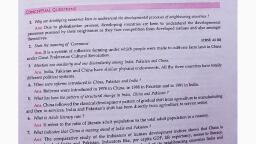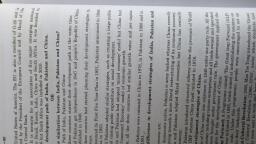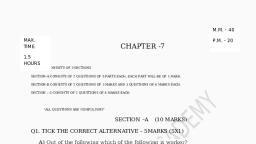Page 1 :
Chapter 1, , INDIAN ECONOMY ON THE EVE OF INDEPENDENCE, India was under the colonial rule of the Brittan for two centuries till 15 august 1947., The main aim of the British rule was to reduce India in to a feeder economy for the rapidly, growing Brittan. The colonial government in India followed a policy of protection and, promotion of the economic interest of Brittan. They want to transform India in to a supplier, of raw materials to Brittan and a consumer of finished goods from Brittan. Let us see the, economic condition of India under their rule., AGRICULTURAL SECTOR, , British rule transformed India in to an agrarian economy. About 85% of Indian, population engaged in agricultural sector. But the agricultural productivity was very low, due to the following factors., (a) Various systems of land settlements : The British introduced Zamindari system, under, which the profit from agricultural sector gone to the hands of the Zamindars instead of, cultivators. They did nothing to improve the conditions of agricultural sector. This lead, misery and tension among the cultivators., (b) Revenue settlement: Under the revenue settlement, Zamindars were asked to deposit, revenue from agricultural sector at specified dates. If they failed to remit the same, they, will loss the rights on lands., (c) Lack of irrigation facilities, (d) Little use of fertilizers, (e) Low level of technology, (f) The partition of India in to Pakistan and Bangladesh received a further setback, since, India’s majority cotton and textile mills were there., INDUSTRIAL SECTOR, , The primary motive of the British colonial government was to reduce India in to a mere, exporter of raw materials to Britain and turn India in to a market for finished products, from Britain. The main features of the industrial sector during their reign were, (a) The world famous Indian handicrafts declined. It leads to massive unemployment in India., (b) Modern industries began to take root in India in the second half of the nineteenth century. It, includes setting up of cotton textiles mills especially in Maharashtra and Gujarat, Jute mills, in Bengal, the Tata Iron and Steel Company (TISCO) established in 1907., (c) No capital goods industries (industries which produce machines) were established, which set, back our industrialization., (d) The operation of the public sector was limited to power generation, railways,, communications, ports etc., FOREIGN TRADE, , India has been an important trading nation since ancient times. But the policies of the, colonial government restricted it. The features of India’s foreign trade during their rule are, (a) India reduced in to a an exporter of primary products like silk, cotton, wool, indigo, sugar etc, and an importer of finished products like cotton, silk, woolen clothes, capital goods etc., (b) Britain maintained a monopoly control over India’s exports and imports. More than half of the, trade was with Britain. The opening of Suez Canal further increased it.
Page 2 :
(c) Huge export Surplus. It means excess of exports over imports. It made the scarcity of, essential goods within the country. More over this surplus was used to meet the expenses, of war, office set up etc by the British., DEMOGRAPHIC CONDITIONS, , The first census during the British period was made in 1881. It showed the following, pathetic condition., (a) The over all literacy rate was less than 16 % - the female literacy was only 7%., (b) Public health facilities were unavailable to majority population. As a result, deaths due to, water and air-born diseases increased., (c) The mortality rate was very high. The infant mortality rate was alarming at 218/1000., (At present it is 63), (d) Life expectancy was also very low – 32 years (at present 63 years)., OCCUPATIONAL STRUCTURE, , Occupational structure means the distribution of working persons among different, sectors. It showed the following features, (a) The agricultural sector accounted the highest work force- 70 to 75% of population. In the, industrial sector it was 10% and the service sector 15 to 20%., (b) Growing regional variation in work force. In Orissa, Rajasthan, Punjab etc work force in, agriculture was high. But in Madras presidency (Tamilnadu, Kerala, Andra and Karnataka), Bengal and Maharashtra it was very low., INFRASTRUCTURE, , Under the colonial regime, the basic infrastructure like railways, ports, water transport,, post and telegraph etc developed. But the motive behind it was to protect the interest of the, colonial government., (a) The roads were built mainly for mobilizing the army within the country and transporting the, raw materials from farms to the railway stations., (b) The introduction of railway in India in 1850 was a revolution. It helped the people to, undertake long distance journey by train. It helped to break geographical and cultural, barriers. It leads to the commercialization of Indian agriculture. It expanded India’s export., Export surplus increased. It made the scarcity of essential goods within the country. More, over this surplus was used to meet the expenses of war, office set up etc by the British., (c) Development of inland trade and sea lines, electric telegraph, postal services etc were the merit, side of the British regime in India., Even though the British regime in India declined our country in some respects, the, Independent Indian government built our economic and social development plans on the, foundation laid by the British., Questions from Public Examinations., 1., 2., 3., 4., , ‘During the colonial period industrial progress of the Indian economy was very slow’. Give reasons for supporting this, statement. (4 score, Imp 2009), ‘India became an exporter of primary products and an importer of finished goods produced in the factories of Britain’., Critically examine the foreign policy adopted by the British in the light of the above statement. (4 score, March 2009)., ‘ The stagnation in agricultural sector was caused mainly because of the various systems of land settlements that were, introduced by the British govt. Do you agree with this statement? Justify your answer. (4 score, March 2010)., ‘The economic policies persuaded by the Colonial govt. in India were concerned more with the protection and promotion of, the economic interest of their home country than with the development of the Indian economy’. Substantiate the statement, with reference to the policies adopted by the Britain in Indian agriculture, Industry and foreign trade. (4 score, Imp 2010)., , 5., , ~~~~~~~~~~~~~~~~~ashraf~~~~~~~~~~~~~~
Page 3 :
Chapter II, , INDIAN ECONOMY, , 1950 – 1990, , India woke to a new dawn of freedom on 15 August 1947. Among the three economic, systems, India adopted Mixed economy. The other two are Capitalism and Socialism. Capitalism, is an economic system in which all means of production are owned and controlled by the private, individuals for profit. Here everything is decided by the market forces of demand and supply., Under Socialism, all means of production are owned and controlled by the society as a whole for, the welfare of the people. Here the key decisions are taken by the government. But in Mixed, economy, all good features of capitalism and socialism can be seen. Here the market forces and, government together decide things., , FIVE YEAR PLANS- GOALS, , The National Planning Commission was established in 1950, with prime minister as the chair, person. It has also a Deputy Chair person . Now NITI AYOG is replaced with NPC. (National, Institution for Transforming India – Chairman- PM, Vice Chairman- Rajiv Kumar, CEOAmiabh Kant, Came in to force on 01/01/2015). Planning started in India in 1951. P. C., Mahalanobis is regarded as the architect of Indian planning. The goals of the five year plans are, classified in short term and long term goals. The main long term goals are, 1. Growth : It refers to an increase in the capacity of the country to produce goods and services. A, good indicator of growth is the increase in GDP. It refers to the money value of all goods and, services produced with in the domestic territory of a country during a year. The GDP is derived, from the various sectors of the economy like agricultural sector, industry and service sectors. This, contribution makes the ‘Structural Composition’ of the economy., 2. Modernization : Adoption of new technology to produce various goods and services is called, modernization. Modernization also includes the change in the social out look of the people ( for, eg. Recognize the equal status of women as men)., 3. Self-reliance : It refers to use of our own resources for our development. It also means, reduction of dependence on foreign countries. The dependence of imported goods, foreign, technology, foreign capital etc may deteriorate our dignity in the world., 4. Equity : It means the getting of the benefits of economic prosperity to the poor. It ensures the, equality in the distribution of income and wealth among the people. It also aims at meeting the, basic needs of the people like food, clothing, shelter, health care etc., INDIAN ECONOMY- AFTER INDEPENDENCE, , Let us see the changes in the Indian economy after the independence., AGRICULTURE., , The independent Indian government introduced various schemes for the rapid growth, of the Indian agricultural sector. It includes, (1) Land reforms:- The British introduced Zamindari system, under which the profit from, agricultural sector gone to the hands of the Zamindars instead of cultivators. They did, nothing to improve the conditions of agricultural sector. This lead misery and tension, among the cultivators., The new Indian government introduced land reforms in India. It means change in, the ownership of land holdings. The main features of this reforms were, (a) Abolition of intermediaries – so that 200 lakh tenants came in to direct contact, with the government., (b) The tillers were made the actual owners of the land, ( c) Fixing of land ceiling- fixing the maximum size of the land a person can own. It, reduced the concentration of land in the hands of a few., The main drawbacks of the reforms are, (a) The poorest of the agricultural labors did not benefit from land reforms., (b) The big land lords challenged the legislation in courts, which delayed, implementation.
Page 4 :
( c) The loop holes in the legislations were exploited by the big land lords., (d) The land reforms were successful in the states of Bengal and Kerala only., (2) Green Revolution :- Green revolution refers to a large increase in the production of, food grains resulting from the use of High Yielding Variety of Seeds, fertiliser, pesticides, and irrigation. The first phase was from 1960s-1970s and second from 1970s-1980s. The, person behind this revolution was Norman Bourlouge. The main advantages of Green, revolution are, (a) It enabled India to attain self sufficiency in food grains., (b) The dependence on foreign countries for food grains declined., (c ) Rapid growth of agricultural output., (d) Increased the market surplus- The portion of the agricultural product sold in the market at a, price by the farmers is called market surplus., (e) The price of the food grains decreased compared to other goods. It benefited the poor., (f) It helped the government to procure sufficient food for future usage., But it is said that, the green revolution increased the disparities between small and, large farmers. The poor can’t get sufficient inputs and can’t control pest attack. However, the government provided loans to small farmers at low interest rate., INDUSTRY, The five year plans gave emphasis on industrial development because (a) it provide stable, employment than agriculture and (b) it promote modernization. The main features of industry, after independence are, Industrial Policy Resolution 1956., It formed the basis of second plan. The main features are, (a) It classified industries in to three- Public sector industries, private sector industries and with both, private and public., (b) No new industries were allowed without a license from government., (c ) The industries established in backward regions were given tax benefits, electricity at low rates etc which, promoted regional equality., A small scale industry is defined as an industrial unit with a maximum investment of rupees, one crore. They are more labor intensive. They create more employment opportunities. But they, can’t compete with the big ones. So, a number of products were reserved for them. More over the, government provided concessions like lower excise duty, loans at low interest rate etc., TRADE, The policy regarding trade during the first seven plans were “inward looking” or “import, substitution”. This policy aimed at the replacement of imports with domestic production., The protection from imports can be done in two ways – tariffs and quotas. Tariffs are the tax, imposed on imports. It make imports more expensive. On the other hand quotas specify the, quantity of goods which cab be imported. The policy of protection was based on the idea that, the, domestic industries of the developing countries are not able to compete with that of developed, countries,, THE EFFECTS OF THE POLICIES, Positive effects., 1. The contribution of industrial sector to the GDP increased from 11.8% in 1950-51 to 24.6% in 1990-91., 2. An annual growth rate of industrial sector rose to 6%., 3. Industrial sector diversified., 4. The promotion of small scale industries gave opportunities to those who wish to enter in business., 5. Protection from foreign competition helped the indigenous industries in electronics and automobile., 6. Public sector developed much., Negative effects, 1. Many public sector firms incurred heavy losses., 2. The need to obtain a license to start an industry was misused by industrial houses., 3. Protection to home producers made the consumers to consume what they produced.
Page 8 :
2009-2010, 673, 860, , Scanned by CamScanner
Page 13 :
2, (i) To reduce the risk from agricultural sector, (iii) to realise more income to the people, , (ii) to produce more employment opportunity, (iv) the non-farm sectors have more dynamic sub, , Scanned by CamScanner
Page 17 :
(i) The shortage of doctors in rural areas persist on a large scale, (j) There is growing incidence of female foeticide in the country, , Scanned by CamScanner
Page 20 :
10. COMPARATIVE, , DEVELOPMENT EXPERIENCE OF INDIA AND ITS, , NEIGHBOURS, Similarities in the Developmental Strategies pursued by India, Pakistan and China., same time. India and, 1. All the three nations started their developmental strategies at the, Pakistan became independent in 1947 and People's Republic of Cnina was estabiished in, , 1949., , 2. Planning started in all countries in the same way. India started it's first five year plan, for 1951-56, Pakistan in 1956 and China 1953., 3.India and Pakistan adopted similar strategies such as large public sector and rising, government expenditure on social development., 4. Till 1980, all the three countries have the s a m e, , growth rates and per capita incomes., , Historical Path of the Developmental Policies in China, China entered in one, the establishnent of the People's Republic of Chína in 1949,, VWit a view to, individuals., the state from private, party rule. All critical sectors were taken over by, launched in, Forward', industrialize the economy on a massive scale, a campaign called "Great Leap, 1958. 'Communes' were started where people collectively cultivate land., , After, , A sever drought caused havoc, in Clina killing 3Qmillion people. Mao. se Tung, , introduced Great Proletarian Culfural Revolution' during 1966-76. Students and professional, , were sent to work and learn from countryside., , intróduced in, it, reforms in phases. It started in 1978. Initially, Commune, introduction, system is the, of, agriculture, foreign trade and investment sectors. The, individuals, and, allocated, to, for use, groups, main in agriculture. Land were divided in small plots,, and, Farmers, 1., two, in, ways, only. Dual pricing was introduced. It refers to the fixing of the price, at the price fixed by the, industrial units were ailowed to sell and purchase inputs and output, vere held at the price prevailing in the, gomeruont 2. The markt prices Other transactions, introduced., was, , China introduced, , -, , -, , market. n order to attract the foreign investors, , 'Special, , Economic Zones', , were, , Historical Path of the Developmental Policies in Pakistan., sectors exist side, Pakistan follows a mixed economy model, where prioate and public, , by side., , l t provide protectiom to domestic manufactures of consumer goods., , Imposed import controls, in, to increased mechanization and increased investment, Introduced green revolution- which lead, , infrastructure., , In 1970 capital goods industries were nationalized., I n 1980s,policy shifted to denationalization and privatization and gave incentives to private, , sector., , Received financial aid from the western, Reforms were initiated in 1988., , countries., , Demographic Indicators., population of, the, one is Indian and another Chinese. But, OEvery siix persons living in the world,, Pakistan is only 1/10 of India or China, low. It is due to the introduction of one child, OBut the growth rate of population in China is very, norm in 1970., , 1the sex ration in three countries are low and biased against females, , 9The fertility rate is low in China (1.8) but very high in Pakistan (5.1), lowest in China ( !28), OHighest density of population is in India(358),, (hina 3037 ani Pakistan, is, i03ó, million,, whilo, h e pomslation of India, Gross Domestic Product, , 162, , as, , ner, , 20mi-GT
Page 21 :
Sectoral Share of Employment and GDP (%) 2008-12, Growth of Gross Domestic Product (%)., 2000 10, , Coun, , 1930-90, , 2000-2010, , 5.7, , .4, , 10.3, , 10.3, , India, Chma, , Pakistan, , Pakistan, , China, , India, , 10, , 20, , Lndustry, , 4, , 26, , Service, , 43, , Agriculture, , 4., , 63, , Distrtbuion of Workjorce, , Contrtbution to GDP, , Sector, , Total, , 100, , 100, , Pakistar, , China, , India, , 34, , 51, , 22, , 100, , 20, , 27, , 3/, , 100, , 100, , 5, 100, , Some Selected Indicators of Human Development, 2009-12, , Item, , India, , Human Development Index (Waluc), , 0.554, , Rank (based on HD, , 65.8, , Lle Expectancy at birth (Years), , Pulistan, , Cluna, , 0515, , 0.699, 101, , 4, , 73.7, , 65.7, 54 9, , Adult Hteracy rate (9% aged 15 and above), , 62.8, , GDP per capita (PPP USS), , 3203, , 7418, , 94, , 2424, , People below poverty line (6) (2004-06), , 29 8, , 28, , 21, 70, , 6, , Infant Mortal1ty Rate (Per 1000 Ive burths), , 48, , Matermal Mortality Rate (Per Tlakh births), , 200, , 260, , 37, , 44, , Population with sustainable access to improved, sanitation (%), 92, , 92, , 43.5, , 9.4, , Population with sustainable access to an improved, , water source (6), 6 of children malnourished (<5, , DEVELOPMENT STRATEGY, , 48, , AN APPRAISAL, , Pakistan 1988. The, Reforms were introduced in China in 1978, India 1991 and, below., summarized, main failures and achievements of these reforms are, , CHINA:-, , reforms as in India., China does not have any compulsion to introduce the economic, cultural revolution etc the, I n spite of the land reforms, collectivization, great leap forward,, , percapita out put remained constant., distribution of food grains through the commune system., , There was more equita, number of people, a, Handing o v e r of olots of land to individuais tor cultivation helped large, much. It lead to the rural development., contributes 15% to GDP., 54%of the work force engaged in the agriculturalsector, 53%., to, GDP,, the, contributes, highest, Manufacturing sector, , A s the economy develops, there is a shift of output and employment from primary to secondary, , and from secondary to service in China., China attained a double digit growth rate., , China lack political freedom and human rights., , PAKISTAN, , o The growth rate of GDP declined from 6.3 in 1980 to 4.i2010, 4.7 % in 2010, , 45%of the work force engaged in the agriculturaB sector, -OA%, , contributes, , GDP, 220%totoGDP, , o Service sectorcontributes the highest to GDPA 54%, {R. S4, from primary, shift, of, a, is, there, output and employment directly, a, As the economy develops,, , to, , service in Pakistan., o, o, , other two., , Pakistan than the, Shifting from primary to service is faster in, Middle east through it's workers., from, Pakistan earned more foreigrn exchange, , And export of, , agricultural products., o Over dependence on foreign loans increased., the three consecutive years 2002-2005., o Pakistan witnessed a high growth rate of 8% for, a The economy is facing high rate of inflation., is, a The, political instability in most of the time., , country, , facing, , INDIA:, , performed moderately, with the democratic frame work., India, Majority people in India still depends up on agriculture., Infrastructure is lácking in many parts, , f the country., , ., , The growth rate of GDP is minute in India. ( 5.7 in 1980 to" 7.4inin1990), 1990, , Service sector contributes the highest to GDP,57%S5|., Foreign debt indebt ness of the country is increasing very large., ****, , . . . . . . . ..ash.09.

